Laser Processing Market
Laser Processing Market Size and Share Forecast Outlook 2025 to 2035
Laser processing market is projected to grow from USD 21.0 billion in 2025 to USD 34.5 billion by 2035, at a CAGR of 5.1%. Fiber will dominate with a 47.0% market share, while cutting will lead the process segment with a 42.0% share.
Laser Processing Market Forecast and Outlook 2025 to 2035
The global laser processing market is valued at USD 21.0 billion in 2025. It is slated to reach USD 34.5 billion by 2035, recording an absolute increase of USD 13.5 billion over the forecast period. This translates into a total growth of 64.3%, with the market forecast to expand at a CAGR of 5.1% between 2025 and 2035.
The overall market size is expected to grow by nearly 1.64 times during the same period, supported by increasing industrial automation adoption, growing demand for precision manufacturing, expanding electric vehicle production, and rising adoption of advanced laser technologies across diverse manufacturing sectors.
Quick Stats for Laser Processing Market
- Laser Processing Market Value (2025): USD 21.0 billion
- Laser Processing Market Forecast Value (2035): USD 34.5 billion
- Laser Processing Market Forecast CAGR: 5.1%
- Leading Laser Type in Laser Processing Market: Fiber
- Key Growth Regions in Laser Processing Market: Asia-Pacific, North America, and Europe
- Key Players in Laser Processing Market: IPG Photonics, Trumpf, Coherent, Han's Laser, Bystronic, Amada

Between 2025 and 2030, the market is projected to expand from USD 21.0 billion to USD 27.2 billion, resulting in a value increase of USD 6.2 billion, which represents 45.9% of the total forecast growth for the decade. This phase of development will be shaped by increasing Industry 4.0 adoption, growing electric vehicle manufacturing, and expanding aerospace component production. Laser equipment manufacturers and industrial users are expanding their processing capabilities to address the growing demand for precision manufacturing and advanced material processing solutions.
Laser Processing Market Key Takeaways
| Metric | Value |
|---|---|
| Estimated Value in (2025E) | USD 21.0 billion |
| Forecast Value in (2035F) | USD 34.5 billion |
| Forecast CAGR (2025 to 2035) | 5.1% |
From 2030 to 2035, the market is forecast to grow from USD 27.2 billion to USD 34.5 billion, adding another USD 7.3 billion, which constitutes 54.1% of the overall ten-year expansion. This period is expected to be characterized by the expansion of ultrafast laser applications, development of AI-integrated processing systems, and growth of additive manufacturing laser technologies. The growing adoption of smart manufacturing and digital factory concepts will drive demand for laser processing equipment with enhanced automation and intelligent control capabilities.
Between 2020 and 2025, the market experienced significant growth, driven by accelerating industrial automation and growing recognition of laser processing as essential technology for precision manufacturing and advanced material processing. The market developed as manufacturers across automotive, electronics, and aerospace sectors recognized the potential for laser technology to improve processing accuracy, reduce production time, and support innovative manufacturing processes while maintaining cost effectiveness and operational flexibility.
Why is the Laser Processing Market Growing?
Market expansion is being supported by the increasing demand for precision manufacturing driven by advancing technology requirements and quality standards, alongside the corresponding need for advanced processing solutions that can provide superior accuracy, speed, and versatility across various automotive, electronics, aerospace, and industrial manufacturing applications. Modern manufacturing companies and industrial facilities are increasingly focused on implementing laser processing solutions that can optimize production efficiency, improve product quality, and provide comprehensive manufacturing capabilities while maintaining operational flexibility and cost competitiveness.
The growing focus on automation and Industry 4.0 integration is driving demand for laser processing systems that can support intelligent manufacturing, enable real-time process control, and ensure comprehensive production optimization through advanced control systems and connectivity features. Manufacturers' preference for technologies that combine precision capabilities with automation integration and data analytics is creating opportunities for innovative laser processing implementations. The rising influence of electric vehicle production and renewable energy manufacturing is also contributing to increased adoption of laser processing systems that can handle advanced materials and complex geometries without compromising processing quality or efficiency.
Segmental Analysis
What factors enable the fiber laser type and cutting process segments to lead market growth and demand?
The market is segmented by laser type, process, and end use. By laser type, the market is divided into fiber, CO₂, and solid-state/ultrafast lasers. Based on process, the market is categorized into cutting, marking, and welding/micromachining. By end use, the market is segmented into electronics, automotive, and aerospace/others applications.
By Laser Type, the Fiber Segment Leads the Market
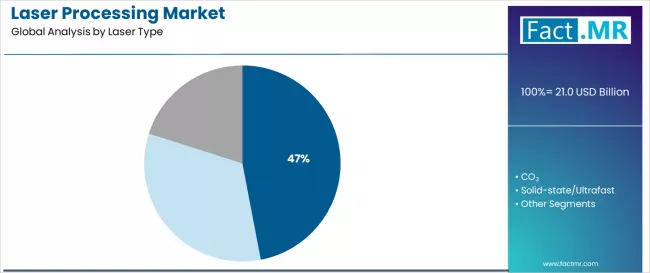
The fiber laser segment is projected to maintain its leading position in the market in 2025 with a 47.0% market share, reaffirming its role as the preferred laser technology for industrial processing applications due to superior efficiency and versatility characteristics. Manufacturing companies and laser system integrators increasingly utilize fiber lasers for their exceptional beam quality, energy efficiency, and proven effectiveness in processing diverse materials while maintaining operational reliability and cost effectiveness. Fiber laser technology's proven performance and operational advantages directly address industry requirements for high-quality processing and operational efficiency across diverse manufacturing applications and material types.
This laser segment forms the foundation of modern industrial laser processing, as it represents the technology with the greatest contribution to processing versatility and established performance record across multiple manufacturing sectors and application types. Industrial laser industry investments in fiber laser technologies continue to strengthen adoption among manufacturers and system integrators. With manufacturing requirements demanding efficiency and quality, fiber lasers align with both processing objectives and operational cost requirements, making them the central component of comprehensive laser processing strategies.
By Process, the Cutting Segment Dominates Market Demand
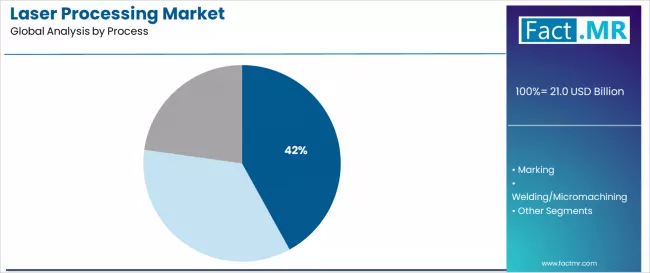
The cutting process segment is projected to represent the largest share of laser processing demand in 2025 with a 42.0% market share, highlighting its critical role as the primary application for laser processing across sheet metal fabrication, automotive component production, and industrial manufacturing operations. Manufacturers prefer laser cutting for their exceptional precision capabilities, processing speed, and proven effectiveness in handling diverse materials while supporting complex geometries and tight tolerances. Positioned as essential processes for modern manufacturing, laser cutting offers both quality advantages and productivity benefits.
The segment is supported by continuous innovation in cutting technology and the growing availability of advanced laser cutting systems that enable superior processing results with enhanced speed and accuracy characteristics. The equipment manufacturers are investing in comprehensive cutting solution programs to support increasingly demanding processing requirements and material diversity demands. As manufacturing complexity increases and precision requirements advance, the cutting process will continue to dominate the market while supporting advanced manufacturing strategies and quality optimization.
What are the Drivers, Restraints, and Key Trends of the Laser Processing Market?
The laser processing market is advancing rapidly due to increasing industrial automation adoption driven by manufacturing efficiency requirements and quality standards, alongside growing demand for precision processing solutions that provide superior accuracy, versatility, and operational efficiency across various automotive, electronics, aerospace, and industrial manufacturing applications. The market faces challenges, including high initial equipment investment costs, skilled operator requirements for complex systems, and maintenance complexity for advanced laser systems. Innovation in automation technologies and intelligent processing systems continues to influence equipment adoption and operational optimization patterns.
Expansion of Electric Vehicle and Battery Manufacturing
The growing electric vehicle sector is driving demand for laser processing equipment that can handle advanced battery materials, lightweight automotive components, and specialized manufacturing requirements through precision cutting, welding, and marking technologies. EV manufacturers require sophisticated laser processing systems that deliver superior performance across diverse material types while maintaining processing quality and production efficiency. Manufacturing companies are increasingly recognizing the competitive advantages of laser processing integration for EV component production and manufacturing differentiation, creating opportunities for specialized equipment designed for electric vehicle manufacturing requirements and next-generation mobility applications.
Integration of Industry 4.0 and Smart Manufacturing
Modern laser processing equipment manufacturers are incorporating Industry 4.0 technologies and smart manufacturing capabilities to enhance operational efficiency, enable predictive maintenance, and support comprehensive production optimization through intelligent control systems and data analytics integration. Leading companies are developing IoT-enabled processing systems, implementing AI-powered process optimization, and advancing automation technologies that optimize laser processing performance while reducing operational complexity and improving productivity. These technologies improve manufacturing efficiency while enabling new production opportunities, including lights-out manufacturing, remote monitoring, and data-driven process enhancement.
Development of Ultrafast and Specialized Laser Technologies
The expansion of advanced applications and precision requirements is driving demand for ultrafast laser processing systems with femtosecond and picosecond capabilities that can provide superior processing quality for specialized materials and micro-manufacturing applications. These advanced systems require sophisticated laser technology and precision control capabilities that exceed traditional processing equipment requirements, creating premium market segments with enhanced processing credentials. Manufacturers are investing in ultrafast laser research and specialized processing technologies to serve high-precision applications while supporting innovation in micro-electronics, medical device manufacturing, and advanced materials processing.
Analysis of the Laser Processing Market by Key Countries
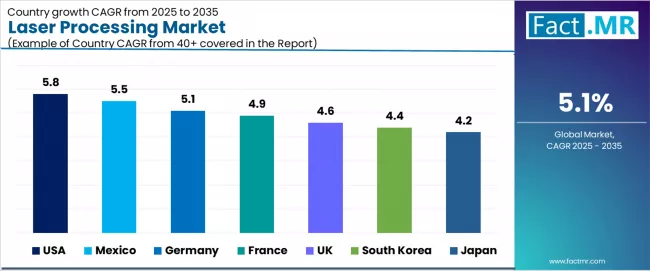
| Country | CAGR (2025-2035) |
|---|---|
| USA | 5.8% |
| Mexico | 5.5% |
| Germany | 5.1% |
| France | 4.9% |
| UK | 4.6% |
| South Korea | 4.4% |
| Japan | 4.2% |
The market is experiencing robust growth globally, with the USA leading at a 5.8% CAGR through 2035, driven by advanced manufacturing capabilities, aerospace industry development, and growing automation adoption supporting laser processing equipment demand. Mexico follows at 5.5%, supported by expanding manufacturing sector, automotive production growth, and increasing industrial automation. Germany shows growth at 5.1%, emphasizing manufacturing excellence, automotive industry leadership, and advanced processing technology development. France demonstrates 4.9% growth, supported by aerospace industry requirements, industrial innovation, and precision manufacturing advancement. The UK records 4.6%, focusing on advanced manufacturing, aerospace applications, and technology development. South Korea exhibits 4.4% growth, emphasizing electronics manufacturing and industrial modernization. Japan shows 4.2% growth, supported by precision manufacturing excellence and advanced technology applications.
Why does the USA lead global market growth through advanced manufacturing innovation?

The USA is projected to exhibit exceptional growth with a CAGR of 5.8% through 2035, driven by advanced manufacturing capabilities and rapidly growing aerospace industry development supporting laser processing adoption among manufacturing companies, aerospace contractors, and automotive producers. The country's innovation leadership and manufacturing sophistication are creating substantial demand for laser processing solutions. Major equipment manufacturers and industrial users are establishing comprehensive processing capabilities to serve both domestic markets and export opportunities.
- Strong aerospace industry and advanced manufacturing requirements are driving demand for laser processing equipment throughout aerospace manufacturers, defense contractors, and precision manufacturing facilities across major industrial regions and technology centers.
- Growing automation adoption and manufacturing modernization are supporting the rapid development of intelligent laser processing systems among companies seeking enhanced productivity and competitive advantages in global manufacturing markets.
How does Mexico demonstrate strong market potential through manufacturing growth?
Mexico is expanding at a CAGR of 5.5%, supported by the country's expanding manufacturing sector, growing automotive production capabilities, and increasing adoption of advanced manufacturing technologies and automation solutions. The country's manufacturing expansion and proximity to major markets are driving demand for sophisticated laser processing applications throughout various industrial sectors. Leading manufacturing companies and equipment suppliers are establishing comprehensive processing facilities to address growing regional and export demand.
- Strong manufacturing sector growth and automotive production expansion are creating opportunities for laser processing adoption across automotive manufacturers, industrial facilities, and manufacturing service providers in major industrial regions and maquiladora operations.
- Growing industrial automation and advanced manufacturing adoption are driving utilization of laser processing technologies among manufacturers seeking enhanced capabilities and competitive positioning in North American markets.
How does Germany demonstrate manufacturing excellence through technology leadership?
Germany is expanding at a CAGR of 5.1%, driven by the country's manufacturing excellence, automotive industry leadership, and comprehensive approach to advanced processing technology supporting sophisticated laser processing equipment utilization. Germany's engineering expertise and quality standards are driving demand for premium laser processing solutions. Leading equipment manufacturers and industrial companies are establishing comprehensive innovation programs for advanced processing technologies.
- Advanced manufacturing standards and automotive industry leadership are creating demand for sophisticated laser processing equipment among automotive manufacturers, machinery producers, and precision manufacturing companies seeking superior processing capabilities and quality assurance.
- Strong engineering excellence and technology development are supporting the adoption of premium laser processing systems across manufacturing facilities, automotive production lines, and specialized processing applications throughout major industrial regions.
How does France focus on aerospace and industrial innovation?
France is expanding at a CAGR of 4.9%, driven by the country's aerospace industry requirements, industrial innovation capabilities, and comprehensive approach to precision manufacturing supporting laser processing integration into advanced manufacturing applications. France's aerospace leadership and technology culture are supporting investment in advanced laser processing technologies. Major aerospace companies and industrial manufacturers are establishing comprehensive processing development programs incorporating laser processing with French manufacturing expertise.
- Advanced aerospace industry standards and industrial innovation focus are creating demand for specialized laser processing equipment throughout aerospace manufacturers, industrial facilities, and technology development centers serving high-precision manufacturing segments.
- Strong precision manufacturing culture and technology leadership are driving the adoption of advanced laser processing applications meeting French manufacturing standards and sophisticated processing requirements across diverse industrial applications.
How does the UK demonstrate market leadership through a focus on aerospace and technology?
The UK is expanding at a CAGR of 4.6%, supported by the country's aerospace industry development, advanced manufacturing initiatives, and growing focus on technology innovation supporting laser processing adoption across manufacturing and technology applications. The UK's manufacturing capabilities and innovation focus are driving demand for advanced laser processing solutions. Leading aerospace and manufacturing companies are investing in processing technology development and manufacturing modernization.
- Aerospace industry development and advanced manufacturing focus are creating opportunities for laser processing equipment throughout aerospace manufacturers, technology companies, and precision manufacturing facilities serving innovative manufacturing applications.
- Strong technology innovation and manufacturing modernization are driving the adoption of intelligent laser processing systems across production facilities, aerospace operations, and specialized manufacturing applications serving technology-focused market segments.
How does South Korea demonstrate technology leadership through a focus on electronics?
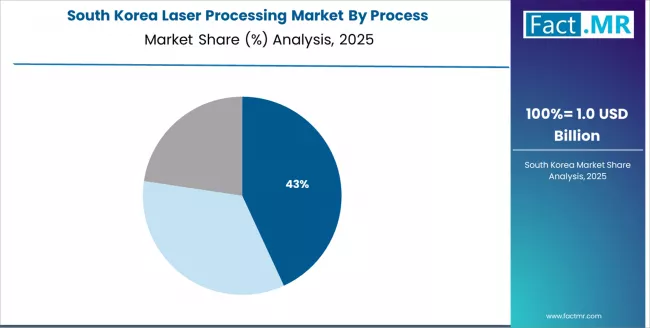
South Korea is expanding at a CAGR of 4.4%, supported by the country's electronics manufacturing leadership, industrial modernization initiatives, and strong focus on advanced processing technology supporting laser processing adoption in technology applications. The nation's technology capabilities and manufacturing sophistication are driving demand for sophisticated laser processing solutions. Leading electronics and technology companies are investing extensively in advanced processing equipment and manufacturing automation.
- Electronics manufacturing leadership and advanced processing requirements are creating demand for specialized laser processing equipment throughout electronics manufacturers, technology producers, and precision manufacturing facilities seeking enhanced processing capabilities.
- Strong industrial modernization and technology advancement are supporting the adoption of intelligent laser processing systems designed for electronics applications and specialized technology manufacturing requirements across diverse industrial sectors.
How does Japan demonstrate a premium focus through precision manufacturing excellence?
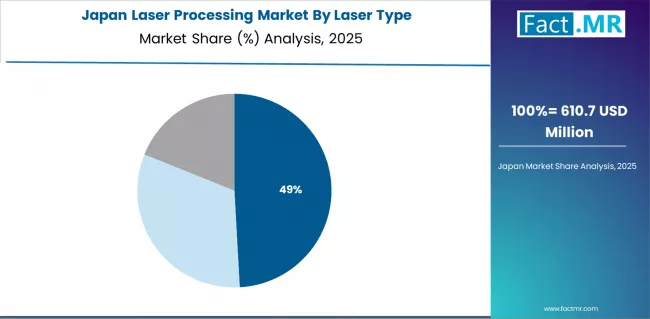
Japan is expanding at a CAGR of 4.2%, supported by the country's precision manufacturing excellence, advanced technology capabilities, and strong focus on quality and innovation supporting premium laser processing utilization in specialized applications. Japan's technological sophistication and quality consciousness are driving demand for precision laser processing products. Leading technology companies are investing in specialized capabilities for advanced processing applications and precision technology development.
- Advanced precision manufacturing and quality focus are creating opportunities for premium laser processing equipment throughout high-end manufacturing facilities, precision machinery producers, and specialized technology companies serving quality-critical manufacturing applications.
- Strong technology innovation and precision focus are driving adoption of advanced laser processing systems meeting Japanese manufacturing standards for excellence and technological sophistication across diverse precision applications.
Europe Market Split by Country
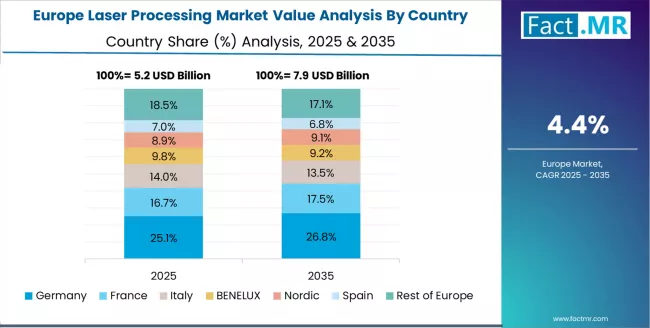
The laser processing market in Europe is projected to grow from USD 6.8 billion in 2025 to USD 11.0 billion by 2035, registering a CAGR of 4.9% over the forecast period. Germany is expected to maintain leadership with a 42.1% market share in 2025, moderating to 41.9% by 2035, supported by manufacturing excellence, automotive industry leadership, and advanced processing technology development.
France follows with 20.4% in 2025, projected to reach 20.6% by 2035, driven by aerospace industry requirements, industrial innovation capabilities, and precision manufacturing advancement. The United Kingdom holds 17.6% in 2025, expected to reach 17.7% by 2035 due to aerospace development and advanced manufacturing initiatives. Italy commands 11.8% in 2025, rising to 11.9% by 2035, while Spain accounts for 6.2% in 2025, reaching 6.3% by 2035. The Rest of Europe region is anticipated to hold 1.9% in 2025 and 1.6% by 2035, reflecting steady advanced manufacturing adoption in Nordic countries and emerging technology markets in Eastern European countries.
How is the competitive landscape of the laser processing market structured and what key factors shape competition?
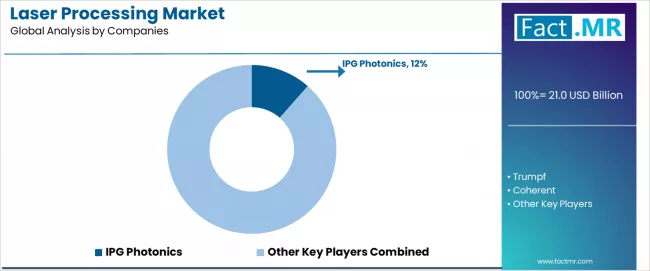
The market is characterized by competition among established laser manufacturers, integrated system providers, and specialized processing equipment companies. Companies are investing in laser technology advancement, automation system integration, application-specific solution development, and comprehensive service capabilities to deliver high-performance, reliable, and cost-effective laser processing solutions. Innovation in fiber laser efficiency, AI-powered process control, and intelligent manufacturing integration is central to strengthening market position and competitive advantage.
IPG Photonics leads the market with an 11.5% share, offering comprehensive laser processing solutions with focus on fiber laser technology, energy efficiency optimization, and extensive global service networks serving diverse manufacturing and industrial applications. The company continues investing in advanced laser technologies and intelligent processing capabilities while expanding production capacity and technical support services. Trumpf provides integrated laser processing systems with focus on automation and Industry 4.0 integration. Coherent specializes in advanced laser technologies and precision applications. Han's Laser focuses on comprehensive processing solutions and Asian market leadership. Bystronic emphasizes sheet metal processing and automation integration. Amada offers integrated fabrication solutions with laser processing capabilities.
Key Players in the Laser Processing Market
- IPG Photonics
- Trumpf
- Coherent
- Han's Laser
- Bystronic
- Amada
- nLIGHT
- Jenoptik
- Rofin
- Fanuc
Scope of the Report
| Items | Values |
|---|---|
| Quantitative Units (2025) | USD 21.0 billion |
| Laser Type | Fiber, CO₂, Solid-state/Ultrafast |
| Process | Cutting, Marking, Welding/Micromachining |
| End Use | Electronics, Automotive, Aerospace/Others |
| Regions Covered | Asia-Pacific, North America, Europe, Latin America, Middle East & Africa |
| Countries Covered | USA, Mexico, Germany, France, UK, Japan, South Korea, and 40+ countries |
| Key Companies Profiled | IPG Photonics, Trumpf, Coherent, Han's Laser, Bystronic, Amada |
| Additional Attributes | Dollar sales by laser type and process, regional demand trends, competitive landscape, technological advancements in laser processing, automation development, Industry 4.0 integration, and manufacturing optimization |
Laser Processing Market by Segments
-
Laser Type :
- Fiber
- CO₂
- Solid-state/Ultrafast
-
Process :
- Cutting
- Marking
- Welding/Micromachining
-
End Use :
- Electronics
- Automotive
- Aerospace/Others
-
Region :
-
Asia-Pacific
- Japan
- South Korea
- China
- India
- Australia
- Rest of Asia-Pacific
-
North America
- United States
- Canada
- Mexico
-
Europe
- Germany
- United Kingdom
- France
- Italy
- Spain
- Netherlands
- Rest of Europe
-
Latin America
- Brazil
- Argentina
- Rest of Latin America
-
Middle East & Africa
- Kingdom of Saudi Arabia
- South Africa
- Rest of Middle East & Africa
-
Table of Content
- Executive Summary
- Global Market Outlook
- Demand to side Trends
- Supply to side Trends
- Technology Roadmap Analysis
- Analysis and Recommendations
- Market Overview
- Market Coverage / Taxonomy
- Market Definition / Scope / Limitations
- Market Background
- Market Dynamics
- Drivers
- Restraints
- Opportunity
- Trends
- Scenario Forecast
- Demand in Optimistic Scenario
- Demand in Likely Scenario
- Demand in Conservative Scenario
- Opportunity Map Analysis
- Product Life Cycle Analysis
- Supply Chain Analysis
- Investment Feasibility Matrix
- Value Chain Analysis
- PESTLE and Porter’s Analysis
- Regulatory Landscape
- Regional Parent Market Outlook
- Production and Consumption Statistics
- Import and Export Statistics
- Market Dynamics
- Global Market Analysis 2020 to 2024 and Forecast, 2025 to 2035
- Historical Market Size Value (USD Million) Analysis, 2020 to 2024
- Current and Future Market Size Value (USD Million) Projections, 2025 to 2035
- Y to o to Y Growth Trend Analysis
- Absolute $ Opportunity Analysis
- Global Market Pricing Analysis 2020 to 2024 and Forecast 2025 to 2035
- Global Market Analysis 2020 to 2024 and Forecast 2025 to 2035, By Laser Type
- Introduction / Key Findings
- Historical Market Size Value (USD Million) Analysis By Laser Type, 2020 to 2024
- Current and Future Market Size Value (USD Million) Analysis and Forecast By Laser Type, 2025 to 2035
- Fiber
- CO₂
- Solid-state/Ultrafast
- Y to o to Y Growth Trend Analysis By Laser Type, 2020 to 2024
- Absolute $ Opportunity Analysis By Laser Type, 2025 to 2035
- Global Market Analysis 2020 to 2024 and Forecast 2025 to 2035, By Process
- Introduction / Key Findings
- Historical Market Size Value (USD Million) Analysis By Process, 2020 to 2024
- Current and Future Market Size Value (USD Million) Analysis and Forecast By Process, 2025 to 2035
- Cutting
- Marking
- Welding/Micromachining
- Y to o to Y Growth Trend Analysis By Process, 2020 to 2024
- Absolute $ Opportunity Analysis By Process, 2025 to 2035
- Global Market Analysis 2020 to 2024 and Forecast 2025 to 2035, By Region
- Introduction
- Historical Market Size Value (USD Million) Analysis By Region, 2020 to 2024
- Current Market Size Value (USD Million) Analysis and Forecast By Region, 2025 to 2035
- North America
- Latin America
- Western Europe
- Eastern Europe
- East Asia
- South Asia and Pacific
- Middle East & Africa
- Market Attractiveness Analysis By Region
- North America Market Analysis 2020 to 2024 and Forecast 2025 to 2035, By Country
- Historical Market Size Value (USD Million) Trend Analysis By Market Taxonomy, 2020 to 2024
- Market Size Value (USD Million) Forecast By Market Taxonomy, 2025 to 2035
- By Country
- USA
- Canada
- Mexico
- By Laser Type
- By Process
- By Country
- Market Attractiveness Analysis
- By Country
- By Laser Type
- By Process
- Key Takeaways
- Latin America Market Analysis 2020 to 2024 and Forecast 2025 to 2035, By Country
- Historical Market Size Value (USD Million) Trend Analysis By Market Taxonomy, 2020 to 2024
- Market Size Value (USD Million) Forecast By Market Taxonomy, 2025 to 2035
- By Country
- Brazil
- Chile
- Rest of Latin America
- By Laser Type
- By Process
- By Country
- Market Attractiveness Analysis
- By Country
- By Laser Type
- By Process
- Key Takeaways
- Western Europe Market Analysis 2020 to 2024 and Forecast 2025 to 2035, By Country
- Historical Market Size Value (USD Million) Trend Analysis By Market Taxonomy, 2020 to 2024
- Market Size Value (USD Million) Forecast By Market Taxonomy, 2025 to 2035
- By Country
- Germany
- UK
- Italy
- Spain
- France
- Nordic
- BENELUX
- Rest of Western Europe
- By Laser Type
- By Process
- By Country
- Market Attractiveness Analysis
- By Country
- By Laser Type
- By Process
- Key Takeaways
- Eastern Europe Market Analysis 2020 to 2024 and Forecast 2025 to 2035, By Country
- Historical Market Size Value (USD Million) Trend Analysis By Market Taxonomy, 2020 to 2024
- Market Size Value (USD Million) Forecast By Market Taxonomy, 2025 to 2035
- By Country
- Russia
- Poland
- Hungary
- Balkan & Baltic
- Rest of Eastern Europe
- By Laser Type
- By Process
- By Country
- Market Attractiveness Analysis
- By Country
- By Laser Type
- By Process
- Key Takeaways
- East Asia Market Analysis 2020 to 2024 and Forecast 2025 to 2035, By Country
- Historical Market Size Value (USD Million) Trend Analysis By Market Taxonomy, 2020 to 2024
- Market Size Value (USD Million) Forecast By Market Taxonomy, 2025 to 2035
- By Country
- China
- Japan
- South Korea
- By Laser Type
- By Process
- By Country
- Market Attractiveness Analysis
- By Country
- By Laser Type
- By Process
- Key Takeaways
- South Asia and Pacific Market Analysis 2020 to 2024 and Forecast 2025 to 2035, By Country
- Historical Market Size Value (USD Million) Trend Analysis By Market Taxonomy, 2020 to 2024
- Market Size Value (USD Million) Forecast By Market Taxonomy, 2025 to 2035
- By Country
- India
- ASEAN
- Australia & New Zealand
- Rest of South Asia and Pacific
- By Laser Type
- By Process
- By Country
- Market Attractiveness Analysis
- By Country
- By Laser Type
- By Process
- Key Takeaways
- Middle East & Africa Market Analysis 2020 to 2024 and Forecast 2025 to 2035, By Country
- Historical Market Size Value (USD Million) Trend Analysis By Market Taxonomy, 2020 to 2024
- Market Size Value (USD Million) Forecast By Market Taxonomy, 2025 to 2035
- By Country
- Kingdom of Saudi Arabia
- Other GCC Countries
- Turkiye
- South Africa
- Other African Union
- Rest of Middle East & Africa
- By Laser Type
- By Process
- By Country
- Market Attractiveness Analysis
- By Country
- By Laser Type
- By Process
- Key Takeaways
- Key Countries Market Analysis
- USA
- Pricing Analysis
- Market Share Analysis, 2024
- By Laser Type
- By Process
- Canada
- Pricing Analysis
- Market Share Analysis, 2024
- By Laser Type
- By Process
- Mexico
- Pricing Analysis
- Market Share Analysis, 2024
- By Laser Type
- By Process
- Brazil
- Pricing Analysis
- Market Share Analysis, 2024
- By Laser Type
- By Process
- Chile
- Pricing Analysis
- Market Share Analysis, 2024
- By Laser Type
- By Process
- Germany
- Pricing Analysis
- Market Share Analysis, 2024
- By Laser Type
- By Process
- UK
- Pricing Analysis
- Market Share Analysis, 2024
- By Laser Type
- By Process
- Italy
- Pricing Analysis
- Market Share Analysis, 2024
- By Laser Type
- By Process
- Spain
- Pricing Analysis
- Market Share Analysis, 2024
- By Laser Type
- By Process
- France
- Pricing Analysis
- Market Share Analysis, 2024
- By Laser Type
- By Process
- India
- Pricing Analysis
- Market Share Analysis, 2024
- By Laser Type
- By Process
- ASEAN
- Pricing Analysis
- Market Share Analysis, 2024
- By Laser Type
- By Process
- Australia & New Zealand
- Pricing Analysis
- Market Share Analysis, 2024
- By Laser Type
- By Process
- China
- Pricing Analysis
- Market Share Analysis, 2024
- By Laser Type
- By Process
- Japan
- Pricing Analysis
- Market Share Analysis, 2024
- By Laser Type
- By Process
- South Korea
- Pricing Analysis
- Market Share Analysis, 2024
- By Laser Type
- By Process
- Russia
- Pricing Analysis
- Market Share Analysis, 2024
- By Laser Type
- By Process
- Poland
- Pricing Analysis
- Market Share Analysis, 2024
- By Laser Type
- By Process
- Hungary
- Pricing Analysis
- Market Share Analysis, 2024
- By Laser Type
- By Process
- Kingdom of Saudi Arabia
- Pricing Analysis
- Market Share Analysis, 2024
- By Laser Type
- By Process
- Turkiye
- Pricing Analysis
- Market Share Analysis, 2024
- By Laser Type
- By Process
- South Africa
- Pricing Analysis
- Market Share Analysis, 2024
- By Laser Type
- By Process
- USA
- Market Structure Analysis
- Competition Dashboard
- Competition Benchmarking
- Market Share Analysis of Top Players
- By Regional
- By Laser Type
- By Process
- Competition Analysis
- Competition Deep Dive
- IPG Photonics
- Overview
- Product Portfolio
- Profitability by Market Segments (Product/Age /Sales Channel/Region)
- Sales Footprint
- Strategy Overview
- Marketing Strategy
- Product Strategy
- Channel Strategy
- Trumpf
- Coherent
- Han's Laser
- Bystronic
- Amada
- nLIGHT
- Jenoptik
- Rofin
- Fanuc
- IPG Photonics
- Competition Deep Dive
- Assumptions & Acronyms Used
- Research Methodology
List Of Table
- Table 1: Global Market Value (USD Million) Forecast by Region, 2020 to 2035
- Table 2: Global Market Value (USD Million) Forecast by Laser Type, 2020 to 2035
- Table 3: Global Market Value (USD Million) Forecast by Process, 2020 to 2035
- Table 4: North America Market Value (USD Million) Forecast by Country, 2020 to 2035
- Table 5: North America Market Value (USD Million) Forecast by Laser Type, 2020 to 2035
- Table 6: North America Market Value (USD Million) Forecast by Process, 2020 to 2035
- Table 7: Latin America Market Value (USD Million) Forecast by Country, 2020 to 2035
- Table 8: Latin America Market Value (USD Million) Forecast by Laser Type, 2020 to 2035
- Table 9: Latin America Market Value (USD Million) Forecast by Process, 2020 to 2035
- Table 10: Western Europe Market Value (USD Million) Forecast by Country, 2020 to 2035
- Table 11: Western Europe Market Value (USD Million) Forecast by Laser Type, 2020 to 2035
- Table 12: Western Europe Market Value (USD Million) Forecast by Process, 2020 to 2035
- Table 13: Eastern Europe Market Value (USD Million) Forecast by Country, 2020 to 2035
- Table 14: Eastern Europe Market Value (USD Million) Forecast by Laser Type, 2020 to 2035
- Table 15: Eastern Europe Market Value (USD Million) Forecast by Process, 2020 to 2035
- Table 16: East Asia Market Value (USD Million) Forecast by Country, 2020 to 2035
- Table 17: East Asia Market Value (USD Million) Forecast by Laser Type, 2020 to 2035
- Table 18: East Asia Market Value (USD Million) Forecast by Process, 2020 to 2035
- Table 19: South Asia and Pacific Market Value (USD Million) Forecast by Country, 2020 to 2035
- Table 20: South Asia and Pacific Market Value (USD Million) Forecast by Laser Type, 2020 to 2035
- Table 21: South Asia and Pacific Market Value (USD Million) Forecast by Process, 2020 to 2035
- Table 22: Middle East & Africa Market Value (USD Million) Forecast by Country, 2020 to 2035
- Table 23: Middle East & Africa Market Value (USD Million) Forecast by Laser Type, 2020 to 2035
- Table 24: Middle East & Africa Market Value (USD Million) Forecast by Process, 2020 to 2035
List Of Figures
- Figure 1: Global Market Pricing Analysis
- Figure 2: Global Market Value (USD Million) Forecast 2020-2035
- Figure 3: Global Market Value Share and BPS Analysis by Laser Type, 2025 and 2035
- Figure 4: Global Market Y to o to Y Growth Comparison by Laser Type, 2025-2035
- Figure 5: Global Market Attractiveness Analysis by Laser Type
- Figure 6: Global Market Value Share and BPS Analysis by Process, 2025 and 2035
- Figure 7: Global Market Y to o to Y Growth Comparison by Process, 2025-2035
- Figure 8: Global Market Attractiveness Analysis by Process
- Figure 9: Global Market Value (USD Million) Share and BPS Analysis by Region, 2025 and 2035
- Figure 10: Global Market Y to o to Y Growth Comparison by Region, 2025-2035
- Figure 11: Global Market Attractiveness Analysis by Region
- Figure 12: North America Market Incremental Dollar Opportunity, 2025-2035
- Figure 13: Latin America Market Incremental Dollar Opportunity, 2025-2035
- Figure 14: Western Europe Market Incremental Dollar Opportunity, 2025-2035
- Figure 15: Eastern Europe Market Incremental Dollar Opportunity, 2025-2035
- Figure 16: East Asia Market Incremental Dollar Opportunity, 2025-2035
- Figure 17: South Asia and Pacific Market Incremental Dollar Opportunity, 2025-2035
- Figure 18: Middle East & Africa Market Incremental Dollar Opportunity, 2025-2035
- Figure 19: North America Market Value Share and BPS Analysis by Country, 2025 and 2035
- Figure 20: North America Market Value Share and BPS Analysis by Laser Type, 2025 and 2035
- Figure 21: North America Market Y to o to Y Growth Comparison by Laser Type, 2025-2035
- Figure 22: North America Market Attractiveness Analysis by Laser Type
- Figure 23: North America Market Value Share and BPS Analysis by Process, 2025 and 2035
- Figure 24: North America Market Y to o to Y Growth Comparison by Process, 2025-2035
- Figure 25: North America Market Attractiveness Analysis by Process
- Figure 26: Latin America Market Value Share and BPS Analysis by Country, 2025 and 2035
- Figure 27: Latin America Market Value Share and BPS Analysis by Laser Type, 2025 and 2035
- Figure 28: Latin America Market Y to o to Y Growth Comparison by Laser Type, 2025-2035
- Figure 29: Latin America Market Attractiveness Analysis by Laser Type
- Figure 30: Latin America Market Value Share and BPS Analysis by Process, 2025 and 2035
- Figure 31: Latin America Market Y to o to Y Growth Comparison by Process, 2025-2035
- Figure 32: Latin America Market Attractiveness Analysis by Process
- Figure 33: Western Europe Market Value Share and BPS Analysis by Country, 2025 and 2035
- Figure 34: Western Europe Market Value Share and BPS Analysis by Laser Type, 2025 and 2035
- Figure 35: Western Europe Market Y to o to Y Growth Comparison by Laser Type, 2025-2035
- Figure 36: Western Europe Market Attractiveness Analysis by Laser Type
- Figure 37: Western Europe Market Value Share and BPS Analysis by Process, 2025 and 2035
- Figure 38: Western Europe Market Y to o to Y Growth Comparison by Process, 2025-2035
- Figure 39: Western Europe Market Attractiveness Analysis by Process
- Figure 40: Eastern Europe Market Value Share and BPS Analysis by Country, 2025 and 2035
- Figure 41: Eastern Europe Market Value Share and BPS Analysis by Laser Type, 2025 and 2035
- Figure 42: Eastern Europe Market Y to o to Y Growth Comparison by Laser Type, 2025-2035
- Figure 43: Eastern Europe Market Attractiveness Analysis by Laser Type
- Figure 44: Eastern Europe Market Value Share and BPS Analysis by Process, 2025 and 2035
- Figure 45: Eastern Europe Market Y to o to Y Growth Comparison by Process, 2025-2035
- Figure 46: Eastern Europe Market Attractiveness Analysis by Process
- Figure 47: East Asia Market Value Share and BPS Analysis by Country, 2025 and 2035
- Figure 48: East Asia Market Value Share and BPS Analysis by Laser Type, 2025 and 2035
- Figure 49: East Asia Market Y to o to Y Growth Comparison by Laser Type, 2025-2035
- Figure 50: East Asia Market Attractiveness Analysis by Laser Type
- Figure 51: East Asia Market Value Share and BPS Analysis by Process, 2025 and 2035
- Figure 52: East Asia Market Y to o to Y Growth Comparison by Process, 2025-2035
- Figure 53: East Asia Market Attractiveness Analysis by Process
- Figure 54: South Asia and Pacific Market Value Share and BPS Analysis by Country, 2025 and 2035
- Figure 55: South Asia and Pacific Market Value Share and BPS Analysis by Laser Type, 2025 and 2035
- Figure 56: South Asia and Pacific Market Y to o to Y Growth Comparison by Laser Type, 2025-2035
- Figure 57: South Asia and Pacific Market Attractiveness Analysis by Laser Type
- Figure 58: South Asia and Pacific Market Value Share and BPS Analysis by Process, 2025 and 2035
- Figure 59: South Asia and Pacific Market Y to o to Y Growth Comparison by Process, 2025-2035
- Figure 60: South Asia and Pacific Market Attractiveness Analysis by Process
- Figure 61: Middle East & Africa Market Value Share and BPS Analysis by Country, 2025 and 2035
- Figure 62: Middle East & Africa Market Value Share and BPS Analysis by Laser Type, 2025 and 2035
- Figure 63: Middle East & Africa Market Y to o to Y Growth Comparison by Laser Type, 2025-2035
- Figure 64: Middle East & Africa Market Attractiveness Analysis by Laser Type
- Figure 65: Middle East & Africa Market Value Share and BPS Analysis by Process, 2025 and 2035
- Figure 66: Middle East & Africa Market Y to o to Y Growth Comparison by Process, 2025-2035
- Figure 67: Middle East & Africa Market Attractiveness Analysis by Process
- Figure 68: Global Market - Tier Structure Analysis
- Figure 69: Global Market - Company Share Analysis
- FAQs -
How big is the laser processing market in 2025?
The global laser processing market is estimated to be valued at USD 21.0 billion in 2025.
What will be the size of laser processing market in 2035?
The market size for the laser processing market is projected to reach USD 34.5 billion by 2035.
How much will be the laser processing market growth between 2025 and 2035?
The laser processing market is expected to grow at a 5.1% CAGR between 2025 and 2035.
What are the key product types in the laser processing market?
The key product types in laser processing market are fiber, co₂ and solid-state/ultrafast.
Which process segment to contribute significant share in the laser processing market in 2025?
In terms of process, cutting segment to command 42.0% share in the laser processing market in 2025.